Manuscript accepted on : 21 July 2016
Published online on: --
Plagiarism Check: Yes
Amina Mostefai and Hassiba Stambouli-Meziane
University of Tlemcen, Faculty of Science, Department of Ecology and Environment, ecology laboratory and Natural Ecosystem Management.
*Corresponding Author E-mail: amina_bio13@hotmail.fr
DOI : http://dx.doi.org/10.13005/bbra/2304
ABSTRACT: This study is devoted to the analysis groups to Rosmarinus officinalis in the coastal region of Tlemcen. The interpretation by the correspondence analysis (A.F.C.) allowed us to identify groups based Rosmarinus officinalis in the coastline and especially in direct relation with limestone and siliceous substrate. Rosmarinus officinalis presents a wide ecological spectrum belongs to the class of Ononido-Rosmarinetea on limestone substrate, in Cisto-Lavanduletea on siliceous substrate and finally Rosmarinea officinalis on a substrate mixture. Using phytosociological and phytodynamiques data, we could understand the evolution of this vegetation, and diversity
KEYWORDS: Phytosociology; phytoécologie; Rosmarinus officinalis; Tlemcen; Algeria; groups
Download this article as:| Copy the following to cite this article: Mostefai A, Stambouli-Meziane H. Groups of Rosmarinus Officinalis in Litorral of Tlemcen Region: Phytosociological Aspects and Phytoecological. Biosci Biotech Res Asia 2016;13(3). |
| Copy the following to cite this URL: Mostefai A, Stambouli-Meziane H. Groups of Rosmarinus Officinalis in Litorral of Tlemcen Region: Phytosociological Aspects and Phytoecological. Biosci Biotech Res Asia 2016;13(3). Available from: https://www.biotech-asia.org/?p=15528 |
Introduction
The Mediterranean coastal ecosystems are characterized by strong climatic and soil constraints, salinity, wind, drought and shallow soil or mobile. The Algerian coast, like Tunisia, is a whole subject to significant human pressure more intense than in the rest of the country. This pressure acts for decades on vegetation and is ongoing .
Analysis of the floristic richness of the various groups, their biological characteristics and chorologic would highlight their floristic originality, their conservation status and, therefore, their heritage value. Dahmani (1997).
This study was performed based on phytosociological surveys to determine the close affinity of different plant groups in relation Rosmarinus officinalis. Second, the knowledge of this rich flora helps make proposals leading to the preservation and improvement of these fragile environments, to limit damage and to promote their development in a rational way.
Materials and Methods
The study area is characterized by great diversity of flora that is related to the combination of environmental factors that are also very varied (variation bioclimatic Action anthropozoogene).
For this study we selected 03 study sites locating in the western part of north western Algeria Figure1. These are located between 34 ° 25 ‘and 35 ° 19’ and west longitude with a 1 ° 19 ‘and 1 ° 44’. They are limited geographically:
the north by the Mediterranean Sea
south of the wilaya of Naama
to the west by the Algerian-Moroccan border
to the east by the province of Temouchent
southeast by the wilaya of Sidi Bel Abbes
These help us to better understand the dynamics of vegetation but also to better understand the ecological factors.
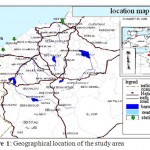 |
Figure 1: Geographical location of the study area
|
To value the groups in Rosmarinus officinalis we conducted 200 surveys in total; and each survey was conducted in a homogeneous floristic area. The surface of the statement must be equal at least to the minimum area, containing virtually all of these species.
Execution of statements accompanied by the raising of stationnels characters. (Location, altitude, exposure, recovery rates, substrate, slope … ..Etc.); Then each species is affected by two indices, the first is abondance- dominance, the second sociability
The abundance – dominance expresses the space occupied by the projection on the ground of all the individuals of each species. This coefficient admits the following scale (Braun Blanquet 1952).
Once the surveys conducted, they were sorted by correspondence analysis (A.F.C) and hierarchical clustering (C.A.H).
For this analysis we will focus on ecological determining the floristic diversity and syntaxonomic analysis will be devoted to the description of phytosociological units related to Rosmarinus officinalis.
Results and Discussion
Table 1: values and inertia ratio of the first AFC axes
| Axis | 1 | 2 | 3 |
| Eigenvalues | 36,791 | 11,171 | 8,613 |
| ℅ of inertia | 24,5 | 7,4 | 3,77 |
The eigenvalues of the first axes are 24.5 and 7.4, respectively, the clouds are therefore really structured on the main map. On this plan opposed sets.
positive Side
Cistus monspeliensis Pistacia lentiscus
Cistus salviifolius Rosmarinus officinalis
Erica multiflora Tetraclinis articulata
Lavandula dentata Teucrium pollium
Micromeria inodora Pinus halepensis
Negatif Side
Chamaerops humilis subsp argentea Stipa tenacissima
Daphne gnidium Stipa torilis
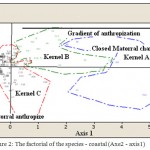 |
Figure 2: The factorial of the species – coastal (Axe2 – axis1)
|
The negative side is represented training Woody chamaephytiques and perennialgeophytiques better adapted to drought, the positive side of the axis is dominated by species characteristic of a mixture of silica and limestone, such as substrate Cistus monspeliensis ; Cistus salviifoliuset Lavandula dentata for the siliceous substrate and Rosmarinus officinalis for the limestone substrate
The positive side translated training in Matorral closed on siliceous substrate belonging to the class of Cisto Rosmarinea while the positive side presents an open Matorral dominated mainly by Chamaerops humilis.
The 2/1 plan shows a regressive evolution of training (closed Matorral to an open matorral) , thus resulting in a regressive evolution of the sward.
Plan 3/1 Figure3
positif Side
Lavandula dentata
Cistus monspeliensis
Micromeria inodora
Schismus barbatus subsp calycinus
Phagnalon saxatile
Teucrium polium subsp capitatum
Plantago major
Ulex parviflorus
negatif Side
Calycotome intermedia
Chamaerops humilis subsp argentea
Daphne gnidium
Gnaphalium luteo-album
Pistacia lentiscus
Rosmarinus officinalis
Teucrium polium subsp polium
Stipa tenacissima
Ulex boivinii
The positive side of this axis usually includes species characterizing a clear matorral on siliceous substrate such as Lavandula dentata; Cistus monspeliensis and Ulex parviflorus.
While the negative side contains the species thus characterizing the class of the Ononido Rosmarinetea on calcareous substrate; and for the majority of the species are xerophytes.Therefore the plan 1/3 reflected a moisture gradient in the direction of the axis.
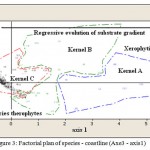 |
Figure 3: Factorial plan of species – coastline (Axe3 – axis1)
|
Interpretation of the hierarchical tree: figure 7
The method of the ascending hierarchical classification applied to 200 records, provides the hierarchical tree. The curve allows us to split 200 surveys in 3 cores A, Band C.
Core A
Micromeria inodora ; Erica multiflora ; Lavandula dentata ; Cistus monspeliensis ; Calycotome intermedia ; Phagnalon saxatile ; Rosmarinus officinalis ; Pistacia lentiscus.
Core A includes the Phanerophytes and the Chamaephytes, these species indicate a purely Woody forest training.
Core B
Pinus halepensis; Tetraclinis articulata ; Helianthemum hirtum ; Schismus barbatus subsp calycinus ; Urginea maritima : Dactylis glomerata ; Catananche lutea ; Ulex parviflorus ; Inula viscosa ; Plantago major ; Trifolium melilotus-ornithopodioides ; Ballota hirsuta ; Helianthemum pilosum ; Rubia perigrina ; Ampelodesma mauritanicum ; Thymus ciliatus ; Linum strictum ; Teucrium pollium capitatum.
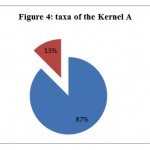 |
Figure 4: taxa of the Kernel A
|
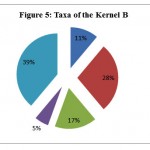 |
Figure 5: Taxa of the Kernel
|
The core B shows a net decrease of the Phanerophytes at 10%; the Chamaephytes pass from 87% to 28% with appearance of other biological types such as Geophytes; Hemi- cryptophytes and a high number of Therophytes of about 39%.
Core C
Aegilops triuncialis ; Ajuga chamaepitys ; Ajuga iva ; Allium nigrum ; Amoides verticillata ; Anacyclus clavatus ;Anagalis arvensis subsp latifolia ;Anagalis arvensis subsp phoenicea ;Anthyllis tetraphylla ;Arenaria emarginata ;Arisarum vulgare ;Aristolochia longa ;Arum italicum ;Asparagus accutifolius ;Asparagus albus ;Asparagus stipularis ;Asperula hirsuta ;Asphodelus microcarpus ;Asteriscus maritimus ;Astragalus lusitanicus ;Avena sterilis ;Bellis annua ;Blakstonia perfoliata ;Borrago officinalis ;Brachypodium distachyum ;Briza minor ;Bromus rubens ;Bryonia dioica ;Calendula arvensis subsp communis var Bicolor ;Calendula suffruticosa ;Calycotome intermedia ;Campanula dichotoma ;Campanula trachelium ;Carduus pycnocephalus ;Catananche coerulea ;Centaurea incana ;Centaurea pullata ;Centaurea solstitialis ;Centaurium umbellatum ;Cephalaria leucantha ;Chamaerops humilis subspargentea ;Chenopodium album ;Chrysanthemum coronarium ;Chrysanthemum grandiflorum ;Cicendia filiformis ;Cistus albidus ;Cistus heterophyllus ;Cistus salvifolius ;Cistus villosus ;Convulvulus althaeoides ;Convulvulus tricolor ;Coris monspeliensis ;Daphne gnidium ;Daucus carota ;Echinaria capitata ;Echium vulgare ;Echium italicum ;Erodium moschatum ;Eryngium maritimum ;Euphorbia felcata ;Euphorbia helioscopia ;Euphorbia peplus ;Fedia cornicopiae ;Ferula communis ;Ferula lutea ;Fumana thymifolia ;Fumaria capreolata ;Galium aparine ;Galium verum ;Genista tricuspidata ;Gladiolus segetum ;Globularia alypum ;Gnaphalium lueo-album ;Halimium halimifolium ;Herniaria hirsuta ;Hippocrepis multisiliquosa ;Hippocrepis unisiliquosa ;Hordeum murinum ;Iris xiphium ;Jasminum fruticans ;Juniperus oxycedrus ;Juniperus phoenicea ;Knautia arvensis ;kundmannia sicula ;Lavendula multifida ;Lavandula stoechas ;Lavatera mauritanica ;Lepturus cylindricus ;Linum suffriticosum ; Linum tenue ;Lobularia maritima ;Lonicera implexa ;Lotus ornithopodioides ;Malva sylvestris ;Marrubium vulgare ;Medicago littoralis ;Micropus bombycinus ;Muscari comosum ;Muscari neglectum ;Nepeta multibracteata ;Olea europea ;Ononis natrix ;Ononis reclinata ;Ophrys speculum ;Ophrys apifera ;Orchis coriophora ;Ornithogalum umbellatum ;Orobanche purpurea ;Oxalis corniculata ;Pallenis spinosa ;Papaver rhoeas ;Paronychia argentea ;Phylleria angustifolia Subsp. Angustifolia ;Pinus maritima ;Plontago logopus ;Plontago psyllium ;Plontago serraria ;Polygala monspeliaca ;Polygala mumbyana ;Polypogon monspeliensis ;Quercus coccifera ;Quercus ilex ;Ranunculus spicatus ;Rananculus repens ;Raphanus raphanistrum ;Reichardia picrioides ;Reichardia tingitana ;Reseda alba ;Reseda lutea ;Retama retam ;Rhamnus lycioides ;Rosa canina ;Rosa sempervirens ;Rumex bucephalophorus ;Ruta chalepensis ;Salvia verbenaca ;Satureja calamintha subsp nepeta ;Scabiosa stellata ;Scilla peruviana ;Scolymus grandiflorus ;Scorpiurus muricatus ;Sedum acre ;Sedm sediforme ;Senecio vulgaris ;Sherardia arvensis ;Silene gallica ;Sinapis arvensis ;Smilax aspera ;Solanum nigrum ;Stelaria madea ;Stipa tenacissima ;Stipa torilis ;Tamus communis ;Teucrium fruticans ;Teucrium polium subsp polium ;Thapsia garganica ;Thymus hirtus ;Tolpis barbata ;Torilis nodosa ;Trifolium angustifolium ;Trifolium campestre ;Trifolium stelLatum ;Tulipa sylvestris ;Ulex boivini ;Vella annua ;Veronica persica ;Vicia sativa angustifolia ;Vicia villosa dasycarpa ;vibernum tinus ;Viola arborecens ;Xeranthemum inapertum
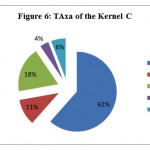 |
Figure 6: TAxa of the Kernel C
|
The Core C, The Therophytes Takes The Extent On Other Biological Types With 61%; Then Come The Chamaephytes With 18%; Geophytes; Hemi- Cryptophytes And Finally The Phanerophytes With 4%.
The Phytosociological Status Of These Species Allows Us To Relate These Core To;
The Class Of Quercetea Ilicis Braun-Blanquet (1974) For The Kernel That
Includes Most Of The Forest And Establish Such As Groupings Asparagus Acutifolius ; Daphne Gnidium ; Juniperus Oxycedrus , Olea Europea ; Phylleria Angustifolia Subsp Angustifolia : Quercus Ilex And Rosa Sempervirens. This Class Combines The Sclerophyllous Formations Around The Mediterranean. Dahmani (1997)
The Order Of Pistacio- Rhamnetalia Alaterni Rivas-Martinez (1974) WithThe Presence Of Other Sclerophyllous Formations More Degraded As: Ampelodesma Mauritanicum ; Asparagus Albus ; Jasminum Fruticans ; Juniperus Phoenicea ; Pinus Halepensis. Quezel Et Al (1992) It Brings Together Groups Of Edge, Or Even Coastal Trees, Sometimes Climax, Especially In Semiarid Bioclimatic Zones, Or Leading By Gradual Evolution To Frankly Forest Structures (Quercetea Ilicis), Particularly In Sub-Humid And Humid Vorbeur Teilung.
The Class Of Ononido-Rosmarinetea Or The Classes Of Cisto-Lavanduletea Depending On The Nature Of The Substrate (For Example: Rosmarinus Officinalis In Limestone Substrate And Lavandula Dentata;) Cistus Mospeliensis On Siliceous Substrate). The Stellarietea Mediae Class Which Include Nitrophilous Vegetation Dominated By the Therophytes And Related Cultures. These Species Are Distributed Throughout The Mediterranean Region. The Groupings Of This Class Are Anthropozogenes Which Explains Their Extension To Measure Degrade Environments Dahmani(1984).
Among The Characteristic Species Of This Class Encountered In Our Study Area: Avena Sterilis ; Blakstonia Perfoliata ; Daucus Carota ; Marrubium Vulgare ; Paronychia Argentea ; Schismus Barbatus Subsp Calycinus.
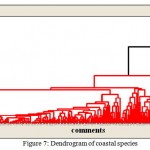 |
Figure 7: Dendrogram of coastal species
|
The Phytosociological And Phyto-Ecologique Groups To Rosmarinus Officinalis Study Concluded That The Study Area Undergoes A Regressive Dynamics Of Vegetation By The Passage From One Stage To Another, Ranging From Matorralisation (Progressive Clarification Of The Tree Stratum Replaced By Of Chamaephytes); The Dematorralisation (Endangered By Grazing Where Grubbing-Up Of The Chamaephytes) Up To Therophytisation (Development Of A Procession Of More Or Less Nitrophilous Therophytes, To Rapid Development).
And According To The Achieved Dendrograms We Were Able To Identify The Main Characteristic Species Of Large Phytosociological Units (Class Of Quercetea Ilicis, Des Ononido-Rosmarinetea, Stellarietea Mediae And Thero-Brachypodietea And Order Of The Pistacio – Rhamnetalia Alaterni).
Species Thymus Ciliatus Subsp. Coloratus ; Micromeria Inodora ; Erica Multiflora; Lavandula Dentata ; Cistus Monspeliensis ; Calycotome Intermedia ; Phagnalon Saxatile ; Pistacia Lentiscus Are More Related To Rosmarinus Officinalis.
References
- Dahmani, Contribution À L’étude Des Groupements À Chêne Vert (Quercus Rotundifolia) Des Monts De Tlemcen (Ouest Algérien), 1984.
- Quezel, M.Barbero, A.Benabid, R.Loisel Et S.Rivas-Martinez, Contribution A La Connaissance Des Matorrals Du Maroc Orientale. Phytocoenologia. –1992 21 (1 – 2) Pp : 117 – 174
- Rivas-Martinez, La Végétation De La Classe Quercetea Ilicis En Espagna Y Portugal. Annales Instituto Botanico Cavanilles, 1974 ,31(2) Pp: 1495-1554.
- Braun-Blanquet, Die Höheren Gesellschaft Seinheiten Der Vegetation Des Sudero West Mediterranen Raumes. S.I.G.M.A, 1974, 204 P.
- M. Dahmani, Le Chêne Vert En Algérie. Syntaxonomie Phytosociologie Et Dynamique Des Peuplements, Thèse Doct. Es-Sciences, Univ. Houari Boumediene, Alger, 1997, 383 Pp.
- J .Braun Blanquet, Phytosociologie Appliquée Comm. S.I.G.M.A , 1952; N°116.
- Stambouli, A.Merzouk, M.Bouazza, Phytosociological Study And Phytoecologique Of Psammophytes Of The Coastline Of The Region Of Tlemcen (Oranie-Algeria)”, International Journal Of Biology, 2015, Doi: Http://Dx.Doi.Org/10.5539/Ijb.V7n2p86.
CrossRef

This work is licensed under a Creative Commons Attribution 4.0 International License.





